Healthy Eating Plan
With so much information available, it can be difficult to decide what a truly "good diet" would be. Vegans tell you it means no animal meat or animal products whatsoever, vegetarians will tell you that it means no meat, those who are on the Paleo diet will say it means lots of meat.
Food is what gives our bodies energy and nutrients to operate properly and with enough energy to complete our daily tasks. To do this, the body needs a wide variety of nutrients, in proper proportion, to prevent obesity, heart disease, cancer, osteoporosis, and other diseases.
What Exactly is a Healthy Diet Plan?
A healthy diet is a varied diet, with small meals eaten at least 6 times a day. This keeps most people from becoming overly hungry and overeating. Aim to break up your food into 3 small meals and 3 snacks.
The ultimate healthy meal consists of a lean protein and a complex carbohydrate. A good example of this would be chicken breast (without skin), with brown rice.
How do I know how much I should eat?
How much you should eat will depend on several factors.
- How much you currently weigh
- How tall you are
- Do you want to lose weight or gain weight?
- How active you are
- How old you are
- Whether or not you are a pregnant or nursing mother
All of the above need to be taken into consideration. For example, a 150 pound, 32 year old woman who is not breastfeeding, but is not very active, will eat fewer calories than a 130 pound 23 year old breastfeed mother who gets an hour or more of exercise each day.
The best way to avoid mistakes and find out how many calories you can consume for your needs is to use an online weight calculator.
Focus on five
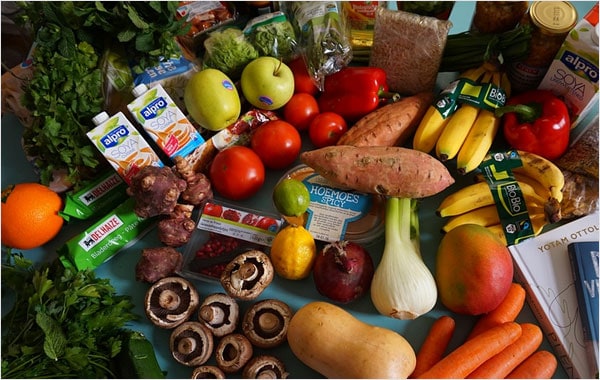 A healthy diet will consist of 5 servings of fruits and/or vegetables each day.
A healthy diet will consist of 5 servings of fruits and/or vegetables each day.
There is nothing healthier on this planet than Mother Nature's fruits and vegetables. These contain antioxidants, phytochemicals, and a huge variety of vitamins and minerals, including vitamin C, the B vitamins, folate, calcium, magnesium, as well as fiber. A healthy diet will consist of 5 servings of fruits and/or vegetables each day.
Nuts are also an important source of nutrition. Nuts contain protein, essential amino acids, fatty acids, vitamin E, selenium, and fiber.
Of course, you can always eat more than 5 servings, but you should never eat less than 5.
What is one serving?
Serving sizes are fairly easy to calculate. Some examples would be:
- 1 average sized piece of fruit, such as bananas, apples, or a pear
- Larger fruits, such as grapefruits or cantaloupe, is one cup of sliced fruit
- 1 Heaping tablespoon of dried fruit, such as raisins, is considered one serving
- Beans, peas, or pulses would be 3 heaping tablespoons
- Most vegetables are one cup, except for starchy vegetables, such as potatoes or corn, these are half cup servings
- Sweet potatoes and yams would be half cup servings
- Squash is a one cup serving
The Importance of Choosing the Right Protein, Carbohydrates and Fats
No healthy diet would be complete without a discussion about how to choose the right proteins, carbs and healthy fats and avoid the ones that are so bad for our health.
FATS: THE GOOD, THE BAD, AND THE UGLY
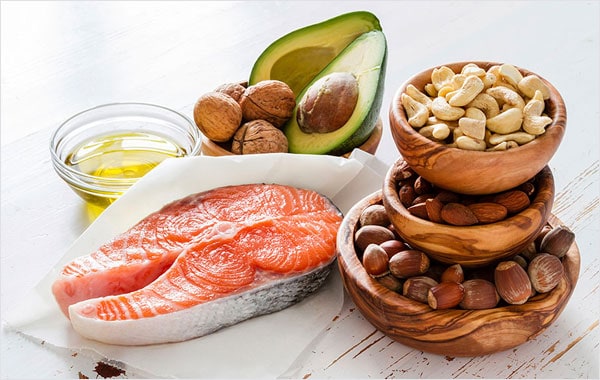 Avoid trans-fats and saturated fats like the plague. Good fats are polyunsaturated and monounsaturated like fish, nuts, avocado and oils.
Avoid trans-fats and saturated fats like the plague. Good fats are polyunsaturated and monounsaturated like fish, nuts, avocado and oils.
Most people try to avoid fat because they believe that fat will make them fat. This isn't always true. Fats that you want to avoid are trans-fats and saturated fats. These are the types of fats that lead to heart disease and weight gain. While the body needs a little saturated fat, it doesn't need very much and you should get it from natural sources such as cheese and almond milk.
This is why the Mediterranean diet is high fat, but heart healthy. The fats consumed, such as olive oil, are the good type of fat.
The following is a list of the good and the bad fats. The ugly part? That's what happens to your body when you indulge in unhealthy fats too often.
Good fats are polyunsaturated and monounsaturated. You can find these in:
- Most fish, including tuna, trout, sardines, salmon, and herring
- Olives
- Seeds, such as sunflower or pumpkin
- Nuts
- Nut butters
- Avocados
- Olive oil
- Peanut oil
- Sunflower oil
- Sesame oil
- Safflower oil
Other foods that have small amounts of saturated fat and are good for the body are:
- Lean cuts of beef
- Low fat milk and milk products
- Almond milk
- Soy milk
- Lean cuts of pork
- Chicken, skin removed
- Turkey
- Ostrich
- Feta cheese
- Swiss cheese
- Cottage cheese
- Parmesan cheese
Keep in mind that your body needs very little of these to stay healthy. Guidelines recommend that no more than 7 percent of your daily caloric intake be from these types of saturated fats.
Bad fats
These are the fats you want to avoid like the plague. These types of fat greatly increase cholesterol levels, clog up the arteries, and lead to heart disease.
Bad fats include:
- GMO fats such as canola oil and soybean oil
- Any oil that calls itself “hydrogenated” or “partially hydrogenated”
- Trans fats, which you can find in most fried foods such as potato chips or French fries
- Saturated fats, which are found in margarine, coconut oil, palm oil, lard, and palm oil
- Cholesterol filled foods, including the fatty cuts of meat, and a large amount of full fat dairy products
LET'S TALK ABOUT CARBOHYDRATE
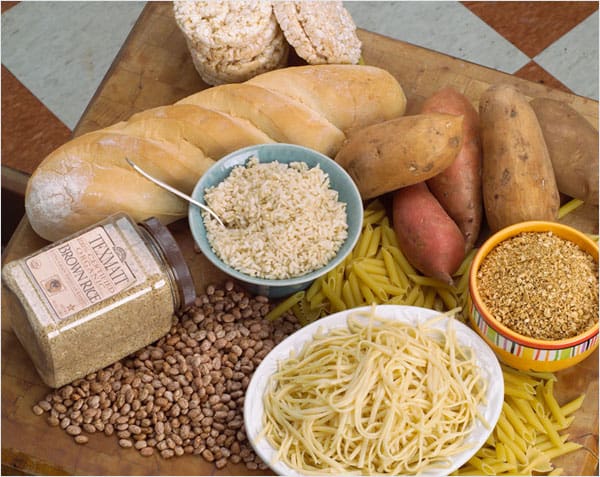 Complex carbs are powerhouses of energy that make you feel full and satisfied.
Complex carbs are powerhouses of energy that make you feel full and satisfied.
No diet plan would be complete without some information about carbohydrates. These are one of the body's main sources of energy and you hear a great deal of talk about how "carbs are bad" for you. The truth is that carbs are great for you- when you pick the right ones!
Simple carbs, sometimes called refined carbs, have had most of their fiber and nutrients removed. They really are just one step above junk foods and empty calories. Sugar and refined grains, such as white bread and pasta, are usually the main problems behind weight gain and health problems.
Simple carbs are exactly the way they sound. Unfortunately, they are also some of our favorite foods. Think sugar, foods that are mainly sugar, such as white bread, donuts, cookies, pie, and sodas. Avoid the main simple carb culprits:
- Sodas
- Sugar
- Candy
- Cake, cookies, donuts
- White rice, bread, or pasta
- Concentrated fruit juice (not freshly squeezed, but the stuff that is sold in bottles, boxes, and cans)
- Most breakfast cereals and breakfast bars
- Pastry like desserts including cookies, cake, pie, donuts, pastry
- Jam and jelly
- Ice cream
- Most desserts
Complex carbs, on the other hand, are powerhouses of energy that make you feel full and satisfied. Add more of the following complex carbs and you will be well on your way towards a healthier you::
- Sweet potatoes
- Regular red and white potatoes
- Whole wheat pasta
- Whole grain breads
- Brown rice
- Quinoa
- Beans and legumes
- Whole grain cereals
- Oats
- Muesli
- Cruciferous vegetables like broccoli, cabbage, and cauliflower
- Crunchy fruit, such as pears and apples
Although many dairy products contain "sugar" , these sugars are mostly in the form of lactose. This means that they actually are more of a carbohydrate as their protein level lowers the glycemic index of the food. This will lead to more stable blood sugar levels and fewer food cravings. Keep in mind that dairy products, while good for the body, should be consumed in moderate amounts.
LET'S TALK ABOUT PROTEIN
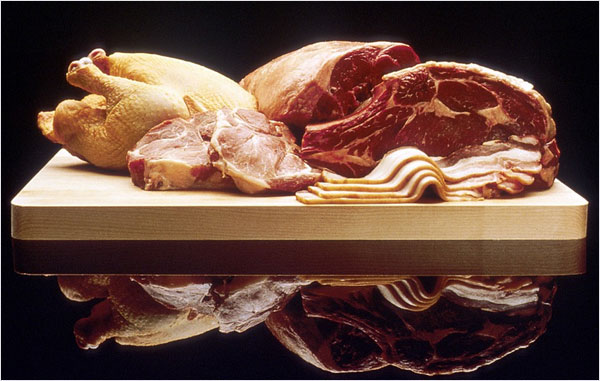 Some of the best sources of lean protein are fish, turkey breast, chicken breast and lean cuts of beef.
Some of the best sources of lean protein are fish, turkey breast, chicken breast and lean cuts of beef.
You might have heard that protein is the "building blocks" of the body, and this is true. The average person needs 0.7 - 1.0 gram of protein for every pound of body weight. It's important to eat lean protein, however, as fatty cuts of meat are filled with artery clogging fat.
Diets that are high in lean protein have been shown to reduce the appetite and lessen hunger pangs. This is because protein reduces the hunger hormone ghrelin, while increasing the hormone which makes you feel full and satisfied, peptide YY.
Not only that, but eating protein filled meals will increase your metabolism, since protein is harder for the body to digest. This means it takes more energy to digest a half pound of steak than a half pound of candy!
Don't believe it? One study, published in Nutrition Metabolism, found that those who increased their protein levels to about 30 percent of their overall caloric intake not only reported fewer cravings, but ate about 450 calories less overall. This resulted in these subjects losing 11 pounds more than those who did not increase their protein levels.
If you want to lose weight more easily, ditch those cravings for junk food, and reduce your overall appetite, you would be wise to increase your protein intake.
Some of the best sources of lean protein are:
- Fish – Salmon, tuna, cod
- Turkey breast
- Chicken breast
- Lean cuts of beef
- Pork loin
- Tofu
- Eggs
- Nuts
- Seeds
- Oysters
- Beef kidney
- Beef liver
While these lists might seem restrictive, no one will die or gain 5 kilos after eating one slice of carrot cake.
Sugar and other sweets are meant to be enjoyed as an occasional treat. Eating these foods every day, or even every week, is not good for your health or your waistline.
Top 10 Worst Food Combinations Ever
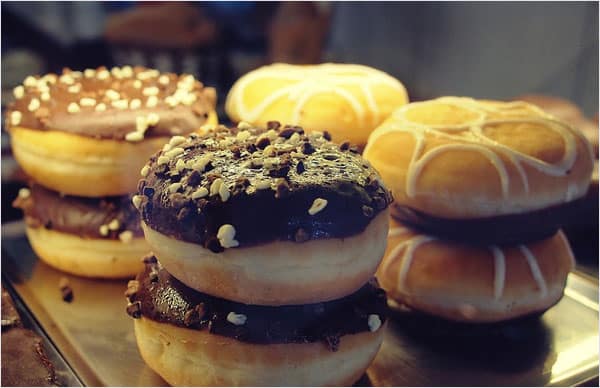 Foods that contain "empty calories" are foods that offer little or no nutrients but lots of calories.
Foods that contain "empty calories" are foods that offer little or no nutrients but lots of calories.
Foods that contain nothing more than sugar and/or unhealthy fat should be consumed only on the rare occasions. The worst offenders are:
- Sugar based foods such as frosting, ice cream, chocolate candy
- Store bought baked goods (donuts, cake, cookies)
- Sugar filled cereals
- Stick margarine
- Bagels
- Sodas
- Fast food such as burgers, French fries, milk shakes
- Toaster pastries, such as Pop Tarts
- Blended coffee drinks, such as the infamous mocha cappuccino
- Cheese “spreads”
Empty calories
We want to add one last thing when talking about foods to avoid; empty calories. Foods that contain "empty calories" are foods that offer little or no nutrients, but lots of calories, usually due to high fat or sugar content. These are the kinds of foods which typically lead to weight gain.
Your body has 6 essential needs: carbs, fat, protein, vitamins, minerals, and water. Empty calories provide you with less than half of the these.
Good examples of "empty calorie" foods are:
- Sodas
- Frozen whipped toppings
- Fruit "drinks" (containing little or no actual fruit juice)
- Beer
- Cookies
- Donuts
- Cake
- Candy (with the exception of dark chocolate)
- Sugar filled chewing gum
- Breakfast bars and cereals
- Bagels
- White bread
- Energy drinks
Easy Tips for Staying Healthy and Eating Well
While many people believe that a healthy eating routine is difficult, it is actually the most natural thing in the world. Take a look at the following tips to help get you started:
- Drink plenty of water throughout the day – a minimum of 8 glasses
- Drinking a glass of water 20 to 30 minutes before a meal will fill you up and allow you to eat less at meal time
- Eat nuts as snacks – their protein levels help to stop you from feeling hungry
- Break up your meals into 5 or 6 mini meals to avoid being hungry
- Avoid alcohol as much as possible
- Eat only lean cuts of meat – remove skin from poultry, cut all visible fat from beef and pork. Look for the word “loin” as this is usually the least fatty cut.
- Be certain that each meal has at least some protein
- Eat oily fish (salmon, tuna, sardines, cod) at least twice a week
- Be very, very picky about the oil you use. Extra virgin olive oil is the best choice
A Healthy Diet Plan Daily Structure
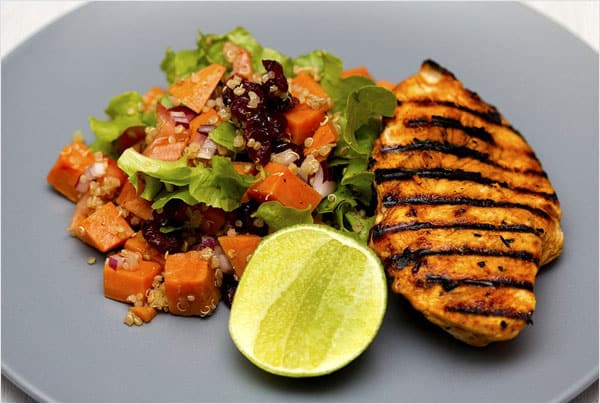 Grilled Chicken Quinoa: The ultimate healthy meal consists of a lean protein and a complex carbohydrate
Grilled Chicken Quinoa: The ultimate healthy meal consists of a lean protein and a complex carbohydrate
A typical diet plan will consist of the following: (180 pound male)
Breakfast
- 30 grams of protein
- 60 grams of whole grains
- 1 cup of dairy
- 1 teaspoon of oil
Lunch
- 60 grams of protein
- 1 cup of vegetables
- 30 grams of grains
- 1 cup of diary
- 1 teaspoon of oil
Dinner
- 60 grams of protein
- 1 cup of vegetables
- 60 grams of grains
- 1 cup of dairy
- ½ cup of fruit
- 3 teaspoons of oil
Snacks - 3 Snacks are allowed each day. Examples are:
- ½ cup of fruit
- ½ cup of vegetables
- 30 grams of whole grain
Of course, some of these items can be switched around to suit your preferences. You might want to remove the oil from your dinner selection, and use it as part of your snack, for example.
Sample Menu
- Breakfast – ½ cup of fruit juice, 1 egg, ½ cup of cooked oatmeal, 1 slice of whole grain bread, 1 teaspoon of butter, 1 teaspoon of jam or jelly, 1 cup fat free milk, coffee.
- Lunch – 60 grams of roasted chicken breast (skin removed), ½ cup sweet potatoes, ½ cup mixed vegetables, 30 gram size whole wheat roll, 1 teaspoon butter, 1 cup fat free milk
- Dinner - 60 grams of water packed tuna on 2 slices of whole grain bread, 2 teaspoons of low fat mayo, 2 slices of tomato, 1 cup of leafy mixed greens, 1 tablespoon of olive oil and vinegar dressing, ½ cup of mixed fruit, 1 cup of fat free milk
- Snacks – ½ cup of carrot slices, ½ fresh cantaloupe, 3 cups air popped popcorn
The Pros and Cons of the Healthy Eating Plan
There are very few drawbacks to this type of eating plan. Perhaps the most difficult part of this diet plan will be to give up sweets and sugar. Most people have a real addiction to sugar, which is one of the worst foods you can consume. You might feel cravings for the first few days while your body adjusts. Try eating a few pieces of dried fruit or super sweet fresh fruit to satisfy your body's cravings for sugar. Rest assured that these cravings pass after two or three days.
Other people find it difficult to give up old habits, such as the drive-though fast food joints for a quick and easy lunch or dinner. Keep in mind that these are merely habits you have fallen into and they can be changed in a matter of a few weeks. Spend a little time planning your weekly menus so you aren't tempted to save time by using a fast food restaurant because you didn't prepare food. You might even consider changing your route to and from work so you don't pass by your old favorite stop.
The pros of this diet are many! You should find that you lose weight slowly, but steadily, without even trying! When you eat the proper combination of carbs and protein, your body feels satisfied, and has the energy to go through its daily routine. Very little sugar, oil, and fat means you greatly lower your risk of diabetes, cancer, stomach and digestive issues, hypertension, stroke, and the number one killer around the globe: heart disease.
One thing you rarely hear about is that people who eat a healthy diet, filled with fresh vegetables and fruit, often have an improved mood. This is because foods from nature contain compounds that not only improve brain function, but the way our bodies make and use hormones.
The right diet can also reduce stress. Studies have found that eating foods high in magnesium (such as beans, bananas, and dark green leafy vegetables) along with two servings of fish each week reduce the body’s level of the stress hormone cortisol.
Last, there are numerous studies which show that those who maintain a healthy weight and eat a balanced, healthy diet live longer than those who suck down the sodas and live on fast food burgers.
The Truth About Exercise
Although you could "diet" your way to a thinner you, your results will be dramatically increased if you got in a little exercise.
Aerobic exercise burns calories and strengthens the heart. Weight training will increase muscle size and boost the metabolism.
To get the maximum benefits of exercise, all you really need to do is some type of aerobic exercise (such as walking, jogging, or dancing) three times a week for about 30 minutes at a time. Add in two days of weight training each week, and you could be losing some substantial weight, as well as giving your body a healthy boost that no magic pill could ever do!
Exercise can help to keep your calorie consumption in check. It doesn't have to be a day at the gym either. Simple things like jogging for 30 minutes can burn as much as 400 calories. A good game of badminton can burn 600 calories in one hour! Everything you do counts towards “exercise.” See how fast it can add up by using this online “daily calories burned” calculator.
You might be thinking that you would love to exercise, but you simply don't have the time. We understand how you feel; everyone seems to be super busy in today's world. However, this doesn't mean you have to be a couch potato!
There is a terrific type of exercise just for people like you called HIIT, which is High Intensity Interval Training. You can get the same benefits as you can from aerobic activity in half the time! It’s also well known for super boosting the metabolism!
For the beginner, a sample workout would be:
- Warm up for 4 minutes (fast walking or easy jogging)
- Sprint or run for 30 seconds, as fast as you can, then walk slowly for 30 seconds. Repeat this for 2 minutes, then rest for 1 minute.
- Repeat this routine 3 more times.
- Cool down by walking for 2 to 5 minutes.
It sounds really simple, and it is! This quick 15 minute workout requires no special tools, no gym membership, nothing but a little space for running.
The Bottom Line
While everyone knows that a healthy eating plan is the best thing we can do for ourselves, we are aware that it isn't easy to do in today's world. If you feel like the steps above are simply overwhelming, take them one step at a time until you can implement the entire diet plan.
If you slip up, don't give up! Go right back to your healthy meals as soon as you can. No one is perfect, so move past your mistake and get back on track!
Adopting a healthy eating plan is not just good for you, but good for your family as well. Even if family members have their doubts, don't let them hold you back. Soon, they will see how your efforts have paid off. You will have more energy, you will lose weight, and you will feel better than you ever have. One day, your friends and family will be asking you, “Hey, what's your secret to looking so slim and healthy?!”